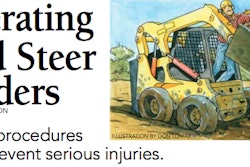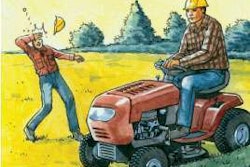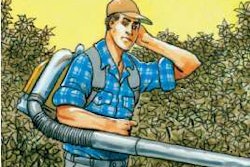4 successful but diverse strategies
By Richard Ries
Obtaining the right part for the right price at the right time is key for equipment managers.
We interviewed managers and executives at four companies with different business models to learn what works best when they source parts. Each has unique insights, but there are commonalities.
•Maintaining a proper inventory of certain parts is critical. Too many parts on the shelves for too long can tie up dollars that can be put to use elsewhere. With too little inventory and equipment, downtime rises to unacceptable levels.
• Information is king. To distinguish between unit price and lifecycle cost, for example, you need to know how many hours you get from an OEM-branded part compared to the will-fit equivalent. If you’re not tracking such data, you can’t make informed decisions when buying parts.
•Each manager uses the Internet extensively for research and routinely orders parts online.
Here’s a roundup of their approaches to sourcing parts. See how it compares to your methods.
Monitor Equipment
Paul Wolbert, U.S. Lawns, advocates new equipment purchases when warranties expire.Mark Alvarez, fleet manager with Maldonado Nursery, Landscape & Irrigation in San Antonio, Texas, prefers original equipment manufacturer (OEM) parts but usually buys through online aftermarket vendors. He estimates 45 percent of the commodity parts (filters, spark plugs, etc.) used by their four locations come from Stens (stens.com). Hard parts for the 100-plus trucks in their fleet — everything from Class 8 tractors to Class 5 vocationals to F250/350 pickups — come from local dealers.
Maldonado’s practice is to control costs by going for longevity on every piece of equipment. Lubrication is a key component of extending service life. All of their lubricating oil, including two-stroke premix oils, are synthetics. Guided by results from oil analysis, Maldonado has set 30,000-mile preventive maintenance intervals for their diesel Class 8 tractors and intervals of up to 12,000 miles for their gas-powered units. Alvarez tailors the company’s parts-purchasing and inventory levels to dovetail with these intervals. Alvarez has also switched the fleet to ISO 100 hydraulic oil, which he says keeps the machines running cooler and quieter.
Ruppert Landscape standardizes equipment purchases between different offices to better manage purchase and service costs.Alvarez mentioned two important considerations when extending service intervals. First, equipment requires close monitoring. Component failure can involve high collateral costs, as when a blown hydraulic hose necessitates soil remediation. Employees must submit inspection reports on their machines each week before receiving their paychecks. Second, the company’s image must be protected despite an aging fleet. Vehicles are washed every weekend; equipment is washed at night as needed. Cosmetic damage is repaired quickly. Excellence is a mindset that can be taught to employees, Alvarez says, and it’s this attention to appearance that helped the company land contracts for grounds maintenance at the Texas governor’s mansion and the state Capitol.
Prefers Warranted Equipment
Paul Wolbert, vice president of U.S. Lawns, takes the opposite approach to updating equipment. Rather than keeping equipment functioning as long as possible, Wolbert advocates replacing machines at the end of their warranty periods. (The exception is two-cycle equipment, which is run one season.)
Ruppert Landscape’s eight service managers do their own purchasing but share cost-savings strategies.With headquarters in Orlando, Florida, U.S. Lawns has more than 240 franchisees providing landscape management services in 39 states. Franchisees use local dealers for equipment purchases, but those purchase arrangements are facilitated by a representative from the equipment manufacturer. To increase buying power, U.S. Lawns recommends the same brands of equipment be used by all franchisees and encourages the use of lease programs where available.
Wolbert cites several advantages. The cost of payments for puchases and leases is a regular part of the franchisees’ profit and loss statements and stays consistent within a few percentage points year after year. Equipment is always in good condition, and failures are generally covered under warranty. The franchisee’s service department is used only for routine procedures, such as replacing belts and filters. Service personnel and equipment requirements are kept low, which offsets some of the cost of monthly equipment payments.
“I know from our data we get better performance, especially longevity and durability, from OEM products.”
Another advantage is that parts needed by franchisees are the ones most commonly available, although Wolbert still hears some concerns about parts availability. “The big three problems are parts listed as in-inventory that aren’t, waiting for another production run of out-of-stock parts, and prodution too low to meet unexpected demand for new products,” he says. “But overall, the system works pretty well.” He notes that maintaining a six-week supply of parts is usually enough to isolate a contractor from disruptions in the supply chain without committing excessively capital to inventory.
Shares Smart Buying Strategy
Maldonado Landscaping strives for maximum longevity with its equipment fleet.Chris Davitt, president, and Reid Altavilla, fleet manager, of Ruppert Landscape emphasize the need to balance centralization and decentralization. With headquarters in Laytonsville, Maryland, (just west of the D.C.–Baltimore corridor), the company serves the mid-Atlantic region from Pennsylvania to Georgia. Eight service managers do their own purchasing, and copies of all purchase orders go to Altavilla. He reviews those P.O.s and invoices, looking for best practices, and then shares the information with the other service managers. If one manager finds a lower price, quicker delivery or other advantage with a vendor, Altavilla disseminates the information to the other shops.
For example, Ruppert Landscape used a tire vendor whose prices were acceptable, but shipping was costly. This changed when the Atlanta manager found an online vendor (truckersb2b.com) whose services are targeted at small fleets and had an extensive distribution network, dramatically lowering shipping costs. The site carries most brands of tires but offers special incentives on Goodyear and Dunlop medium- and heavy-duty commercial truck tires. The net result was 30-percent savings on tire costs, so Altavilla recommended all managers buy tires through the site.
To maximize the advantages of sharing information, Davitt says Ruppert Landscape standardizes manufacturer choices wherever possible. All of their big trucks are Fords. All of their smaller trucks, which are used by managers, are Toyotas. They use one brand of handheld power equipment, Echo. Changing brands occurs only after extensive consideration.
But at the time of our interview, the company was changing from Exmark to Snapper. The decision was driven by cost; the savings will amount to about 30 percent. There were concerns about what Davitt described as Snapper’s “less fully evolved” parts distribution network, but Ruppert and Snapper arrived at a plan to ensure parts availability and provide loaner mowers on site to avert downtime in the event parts are not immediately available.
Buys Through Local Dealers
Hollis Malone is the manager of horticulture and pest control for Gaylord Opryland Resort & Convention Center. With 2,881 guest rooms, 600,000 square feet of meeting and convention space and 172 acres of land, the Gaylord Opryland Resort is the signature property of Gaylord Hotels, which also has properties in Florida, Texas and the Washington D.C. area (see last issue’s “Rebirth of a Landmark,” page 30).
Because the resort has a purchasing department, Malone is less involved in the purchasing process than other fleet managers. He does, however, choose what parts are purchased. He prefers OEM parts from local dealers. In fact, 100 percent of his parts would fit this pattern were it not for a handful of older machines for which dealers no longer stock parts. Although their utilization rate doesn’t justify replacement with new models, these machines have been well cared for. The only parts sources are online vendors who specialize in such esoteric things.
Why the dependence on local dealers for OEM products? “I feel the manufacturer designed and engineered the equipment and specified parts with that design in mind,” Malone says. “I know from our data we get better performance, especially longevity and durability, from OEM products. Lifecycle costs are lower, and it helps ensure warranty coverage.”
Refining Your Strategy
Beyond our sources’ three common suggestions, there seems to be little they share in their parts-sourcing procedures.
Each has made a thoughtful decision to manage parts using specific strategies. Their entire operation, from the brands of equipment they buy to the choice between OEM and will-fit parts to whether to buy from a local dealer or an online vendor, is designed to support that management style. The key to their success is not so much the specifics of what they do as it is the consistency with which they do it. It’s an example of the old maxim that you “plan your work and then work your plan.”










